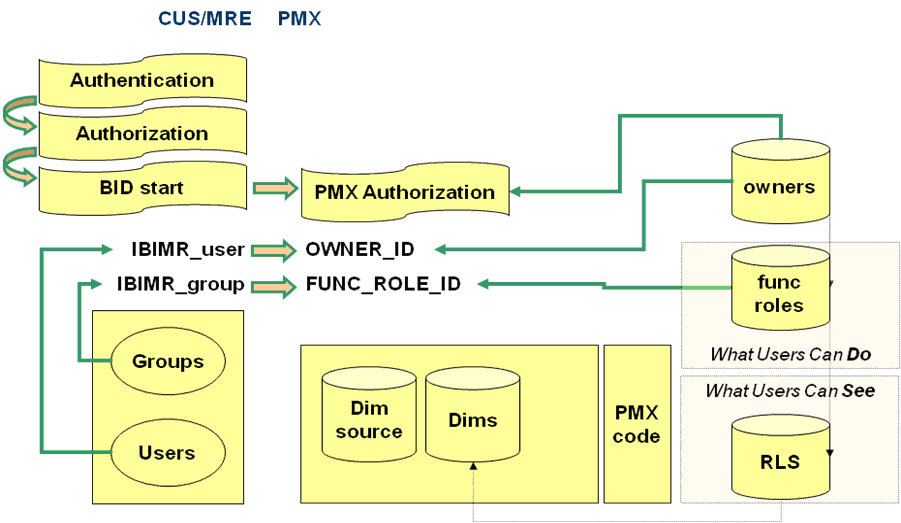Understanding Security and PMF
PMF is a WebFOCUS application designed to run within
security protocols as configured for WebFOCUS MR/CUS (Information
Builders’ named-user system). It is not designed to run for public
or general users. Instead, it identifies its users so that appropriate task
permissions and data security can be enforced.
xAuthentication and Authorization Between Web, MR/CUS, and PMF
Users must sign on through whatever system handles primary
web login. When the user credentials are passed to WebFOCUS MR/CUS
security, by whatever means is used (for example, direct submission
of the credentials via a standard WebFOCUS sign-on page), MR/CUS
either confirms the identity of the user and allows access for a
valid session, or denies the user access because some part of their
credentials do not match.
Once a user is logged in to the MR/CUS system, WebFOCUS turns
control over to any intermediate portal layer (for example, WebFOCUS
BID portal or a SharePoint or WebSphere portal). The PMF contexts
are then called. At this point, both a WebFOCUS and MR cookie have
been created (or their equivalent session IDs). Control is then
passed to PMF, which validates the specific access of the user to
the PMF application itself (the user must be identified using an
Owner record in PMF). If the user is authorized, a WFUSER cookie
is created, which contains the information specific to the PMF session
of the user.

xExternal Security Repository
If you have WebFOCUS MR configured to use an external
security system (such as one based on LDAP, RACF, or ActiveDirectory),
no special configuration needs to be made for your system to work
with PMF. The MR security layer handles the authentication portion
of the sign-on process. Once this is allowed, the user then proceeds
normally into the portal and from there to the PMF application.
In the greatest sense, PMF is “unaware” of the actual protocols
used to authenticate users. However, it is not possible for a user
without proper authentication credentials to access critical data
or perform any change control functions within the PMF application.
x
Web server security (for example, HTTPS) can generally
be used with PMF. PMF obtains the protocol initialization information
from WebFOCUS Client and uses what WebFOCUS tells it to.
Special notice must be made in situations where you have a mixed
web environment. For example, some web resources are delivered using
HTTPS and others using HTTP. Note that as with any secure web application,
PMF will use only the protocol used during initial sign-on. It cannot
support mixed protocol access.
There are situations where a user has aliased web resources.
The most common is using the localhost protected server name during
access. If you mix server contexts when using PMF, you will be liable
to create cross-site scripting errors with PMF. This happens because
much of the PMF user interface is done using JavaScript. The sandbox
protocols for JavaScript do not allow scripts to be launched from
different server contexts.
This is important in protecting you and your users from various
forms of JavaScript injection attacks, which can seriously compromise
security. Please take note of this and adjust your use of your web
environment to respect common security protocols accordingly.
x
PMF can run under both unsecured or secured WebFOCUS
Reporting Server environments. You would most commonly set up your
WebFOCUS Reporting Server to treat the WebFOCUS Client as a trusted
node in order to avoid more common security pitfalls and provide
the best results. However, you can vary your security as needed.
In situations where the authenticated OS user credentials are
being passed through to the WebFOCUS server (as would happen in
particular situations where some older FOCUS applications were ported
to WebFOCUS), note that all PMF users would then need to be in the
OS network bindery (for example, ActiveDirectory or LDAP) before
they would be permitted to access the WebFOCUS Server resources
needed to run PMF.
For example, security protocols under the WebFOCUS Server of
OPSYS and IWA running a secured server can interfere with any WebFOCUS
application if the end user is not authenticated to run against
the Operating System or ActiveDirectory binderies. Please ensure
you have taken the proper steps to provide your users with access
to the PMF application and the ability for the WebFOCUS server to
support their use.
